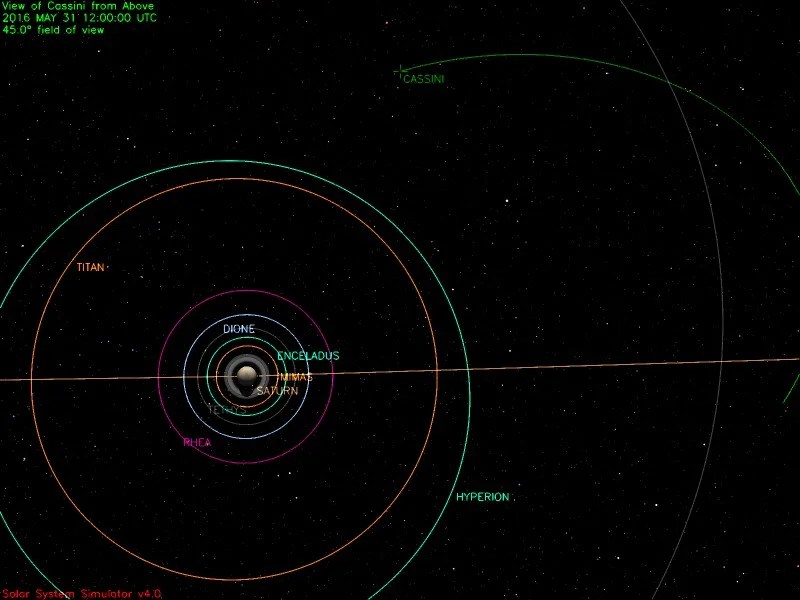4 min read
Cassini is orbiting Saturn with a period of 31.9 days in a plane inclined 36 degrees from the planet's equatorial plane. The most recent spacecraft tracking and telemetry data were obtained on May 25, using one of the 34-meter diameter Deep Space Network stations in Australia. The spacecraft continues to be in an excellent state of health with all of its subsystems operating normally except for the instrument issues described at http://saturn.jpl.nasa.gov/anomalies .
Cassini spent the week falling inbound along its orbit towards Saturn, while most of its activities were controlled by the onboard command sequence S94. On Earth, Sequence Implementation Process teams continued working on the S95 sequence, which will begin executing on June 26, the S96 sequence, which goes active on Sept. 8, and S97, which starts in November.
Wednesday, May 25 (DOY 146)
The Imaging Science Subsystem (ISS) controlled spacecraft pointing for 90 minutes today to make a routine Titan monitoring observation while the planet-like moon was at a distance of 2.2 million kilometers. The Visible and Infrared Mapping Spectrometer (VIMS) rode along taking data. As soon as this was done, ISS led a 60-minute observation in the satellite orbit campaign, recovering sight of known small objects near the planet, and looking for new ones. VIMS and the Composite Infrared Spectrometer (CIRS) rode along. This pair of observations was repeated on Tuesday.
Next, ISS and VIMS began a 28.5-hour observation of Saturn's irregular moon Albiorix. Named for the king of the world in Gallic mythology, this moon has a diameter of about 26 km and moves as far as 23.8 million km away from the planet, along an inclined, highly elliptical orbit.
During a communications session with Earth today, the flight team sent real-time commands to Cassini's Magnetospheric Imaging Instrument (MIMI) to read out portions of its memory and then power off the instrument. This was in response to the anomalous condition that the instrument exhibited last Monday.
Thursday, May 26 (DOY 147)
An image featured this week shows two of Saturn's small icy moons: /resources/17377 .
Friday, May 27 (DOY 148)
VIMS observed a star that is very bright in the infrared, W Hydrae, while it passed behind Saturn's rings. CIRS rode along with this stellar occultation, which lasted 10.3 hours. When it completed, CIRS watched the sunlit side of the rings for 5.3 hours at thermal infrared wavelengths, to measure the albedo of the ring particles. The Ultraviolet Imaging Spectrograph (UVIS) rode along, making its own observation in the ultraviolet part of the spectrum.
The viewing geometry from Cassini in its inclined orbit high above the ring plane is illustrated here.
Saturday, May 28 (DOY 149)
ISS made a 45-minute satellite orbit campaign observation, and then CIRS and VIMS began a 23-hour study of Saturn’s atmosphere, to better understand its composition.
Sunday, May 29 (DOY 150)
Cassini's Navigation team used ISS for 90 minutes to take images of Saturn's large icy moon Rhea against the background stars, for optical navigation purposes. Next, CIRS stared at the sunlit side of Saturn's A ring for ten hours, obtaining thermal-infrared spectra for use in studying ring particle composition. Two of the other telescopic instruments, UVIS and VIMS, participated. Finally, UVIS and VIMS jointly observed Saturn's icy moon Tethys for 2.2 hours to study its composition.
When Cassini turned to communicate with Earth today, the flight team sent commands to restore power to MIMI. The instrument successfully returned to normal operations.
Monday, May 30 (DOY 151)
ISS spent 14.5 hours trained on an orbital arc of Saturn's faint G ring, observing the embedded moonlet Aegaeon while it was sunlit at a low phase-angle. CIRS, VIMS, and UVIS rode along.
Tuesday, May 31 (DOY 152)
UVIS and VIMS observed Tethys again for nearly five hours. VIMS then spent six hours examining the sunlit face of the rings, with CIRS and UVIS riding along.
On five occasions this week, while Cassini's optical instruments were pointing at or near Saturn, ISS carried out two-minute storm-watch observations.
The Deep Space Network communicated with and tracked Cassini five times this week, using stations in Spain and Australia. A total of 88 individual commands were uplinked, and about 950 megabytes of telemetry data were downlinked and captured at rates as high as 124,426 bits per second.








